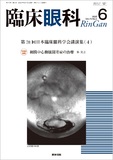Japanese
English
- 有料閲覧
- Abstract 文献概要
- 1ページ目 Look Inside
- 参考文献 Reference
要約 目的:アイドラはドライアイに対する検査機器で,瞬目を動的に撮影し瞬目の程度を定量化することが可能である。眼瞼下垂の手術前後にアイドラを用いて瞬目を検査し,挙筋腱膜前転法とMüller筋タッキングの2つの術式で,手術前後の瞬目の変化を比較した。
対象と方法:2023年1〜6月で,挙筋腱膜前転法,あるいは,Müller筋タッキングを施行し,術前,術後1週間,術後2か月で瞬目検査を施行した症例を対象とした。瞬目の回数,不完全閉瞼の割合を診療録から後ろ向きに調査した。
結果:挙筋腱膜前転群が14例23眼,Müller筋タッキング群が13例24眼であった。瞬目回数は,挙筋腱膜前転群で,術前15.2±7.1回,術後1週間10.1±4.1回(p=0.004),術後2か月13.2±7.5回(有意差なし),Müller筋タッキング群で,術前13.7±6.3回,術後1週間10.5±6.6回(p=0.038),術後2か月12.2±6.2回(有意差なし)であった。不完全瞬目の割合は,挙筋腱膜前転群で,術前19.8±4.1%,術後1週間37.1±5.3%(p=0.002),術後2か月31.9±4.5%(p=0.013)であった。Müller筋タッキング群で,術前18.1±4.3%,術後1週間33.1±7.0%(p=0.027),術後2か月21.2±5.5%(有意差なし)であった。
結論:術後の瞬目回数は,両群とも1週間では有意に減少し,2か月で回復した。不完全瞬目は,両群とも1週間では有意に増加し,2か月後では挙筋腱膜前転群のみ有意な増加が残存した。この差は,挙筋腱膜前転法の術後のドライアイに影響している可能性が考えられる。
Abstract Purpose:The Idra ocular surface analyzer is a diagnostic device for dry eyes that dynamically captures and quantifies blinking. Using this device, we compared the changes in blinking patterns before and after blepharoptosis surgery, through either levator aponeurosis advancement or Müller muscle tucking.
Methods:This study enrolled patients who underwent either levator aponeurosis advancement or Müller muscle tucking between January and June 2023. Blinking was assessed preoperatively and 1 week and 2 months postoperatively. Blink and incomplete blink rates were retrospectively evaluated from medical records.
Results:The levator aponeurosis advancement group included 23 eyes(14 patients), while the Müller muscle tucking group included 24 eyes(13 patients). In the levator aponeurosis advancement group, the mean blink rate was 15.2±7.1 preoperatively, 10.1±4.1 at 1 week(p=0.004), and 13.2±7.5 at 2 months postoperatively(n.s.). In the Müller muscle tucking group, the mean blink rate was 13.7±6.3 preoperatively, 10.5±6.6 at 1 week(p=0.038), and 12.2±6.2 at 2 months postoperatively(n.s.). The incomplete blink rate in the levator aponeurosis advancement group was 19.8±4.1% preoperatively, 37.1±5.3% at 1 week(p=0.002), and 31.9±4.5% at 2 months postoperatively(p=0.013), while in the Müller muscle tucking group, this rate was 18.1±4.3% preoperatively, 33.1±7.0% at 1 week(p=0.027), and 21.2±5.5% at 2 months postoperatively(n.s.).
Conclusion:The blink rate was significantly lower in both groups at 1 week postoperatively, with full recovery by 2 months. The incomplete blink rate was significantly higher in both groups at 1 week postoperatively;however, at 2 months, a significant increase persisted only in the levator aponeurosis advancement group. This difference may be attributed to the development of postoperative dry eyes in patients who underwent levator aponeurosis advancement.

Copyright © 2025, Igaku-Shoin Ltd. All rights reserved.


